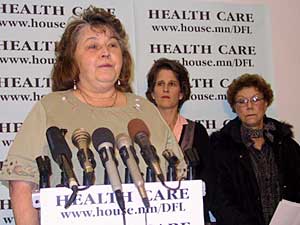|
Audio
Photos
More from MPR
Resources
Your Voice
|
Diabetics on state insurance feel sting of budget cuts
November 25, 2003
DFL lawmakers say the budget cuts made last session are creating life-threatening problems for some people enrolled in the state's subsidized insurance plan. The 2003 Legislature cut health benefits for about 20,000 low-income adults without children. Democrats say the problem is particularly acute for diabetics. They say medical supplies such as glucose testing strips are no longer covered, which will result in more expensive emergency room visits for many diabetics.
St. Paul, Minn. — Nancy Bergeson of Inver Grove Heights has had diabetes since 1985. She's disabled, and has been on the state's MinnesotaCare subsidized health insurance program for more than a year.
Bergeson says MinnesotaCare used to cover the cost of her glucose testing strips, which help her monitor her blood sugar levels so she knows how much insulin to take. The strips cost about $1 apiece, and Bergeson says she uses as many as eight a day. But when she went to the pharmacist last month, she was told her insurance no longer covered the testing strips.
"I said, 'This can't be true! What am I going to do? I have MinnesotaCare,'" Bergeson says. "I was in tears. And I said, 'Where do I go?' They said, 'We don't know, it was just cut from the budget.'"
 | |||
Bergeson says she can't afford to pay for the testing strips, so she started guessing how much insulin to take. She said she overdid it and ended up in the emergency room -- at a cost of $4,400.
Diabetes experts say diabetics have to monitor their blood sugar levels, or they could end up with long-term complications. Dr. Michael Gonzalez-Campoy chairs the Diabetes Steering Committee for the state Health Department. He says paying for test strips saves money down the road.
"For us to turn our back on people that have the disease, that spend their lives taking care of themselves, and telling them, 'No, we won't give you the tools to take better care of yourself,' is foolish," says Gonzalez-Campoy.
State officials say the state's fiscal crunch forced them to choose between reducing benefits for adults without children, or dropping coverage entirely. Human Services Commissioner Kevin Goodno says none of Minnesota's neighboring states offers a similar program.
"In Wisconsin and Iowa, North Dakota, South Dakota, a program for single adults without dependent children above 75 percent of poverty isn't there," Goodno says. "The program is being criticized because it doesn't provide enough, but when you look at what other states are doing, it's a program that other states aren't even doing in the first place."
|
The program is being criticized because it doesn't provide enough, but when you look at what other states are doing, it's a program that other states aren't even doing in the first place.
- Kevin Goodno, Human Services commissioner |
Goodno says when MinnesotaCare was created in 1992, it covered only adults with children. It was later expanded to adults without children. Goodno says MinnesotaCare still covers medical supplies for adults with children.
House Democrats say they'll try to restore the MinnesotaCare cuts for the 20,000 adults without children. They want to cover medical supplies, and also eliminate a $5,000 cap on outpatient care. Rep. Tom Huntley, DFL- Duluth, says state officials estimate the cost savings of the benefit cuts at $98 million.
"We have, in effect, saved $98 million for the state by taking it out of the hide of these 20,000 people," says Huntley. "I don't think there's $98 million in savings there, because if these people don't get the treatment they need, they're not going to go away. They're still going to show up at emergency rooms, they're still going to get treated and somebody's going to pay."
Huntley didn't say how DFLers would come up with another $98 million to balance the budget if they restore the benefits. Commissioner Goodno says there's nowhere else to cut in human services.
"There's only two choices in coming up with $98 million. Either you raise taxes or you cut other programs," says Goodno. "And if they say cut other programs or cut government spending, I would ask them, which programs? Or what taxes are you going to raise?"
Last session, House DFLers proposed raising income taxes on the state's wealthiest taxpayers, while cutting taxes for low-to-middle-income earners. Gov. Pawlenty says if Democrats continue to propose restoring budget cuts from last session, the state will soon find itself facing another deficit.
|
News Headlines
|
Related Subjects
|

